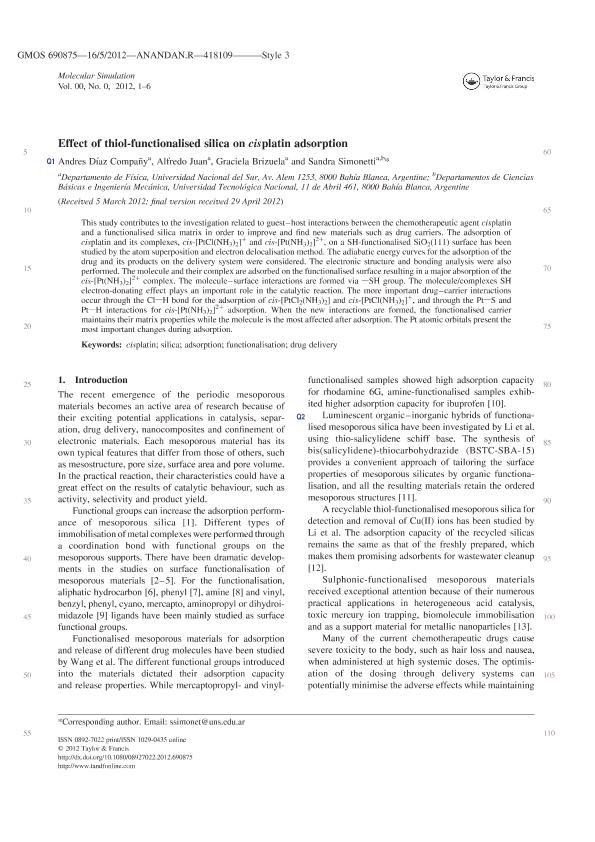Mostrar el registro sencillo del ítem
dc.contributor.author
Díaz Compañy, Andres Carlos Daniel

dc.contributor.author
Juan, Alfredo

dc.contributor.author
Brizuela, Graciela Petra

dc.contributor.author
Simonetti, Sandra Isabel

dc.date.available
2018-12-04T13:12:22Z
dc.date.issued
2012-11
dc.identifier.citation
Díaz Compañy, Andres Carlos Daniel; Juan, Alfredo; Brizuela, Graciela Petra; Simonetti, Sandra Isabel; Effect of thiol-functionalised silica on cis platin adsorption; Taylor & Francis Ltd; Molecular Simulation; 38; 13; 11-2012; 1055-1060
dc.identifier.issn
0892-7022
dc.identifier.uri
http://hdl.handle.net/11336/65678
dc.description.abstract
This study contributes to the investigation related to guest-host interactions between the chemotherapeutic agent cisplatin and a functionalised silica matrix in order to improve and find new materials such as drug carriers. The adsorption of cisplatin and its complexes, cis-[PtCl(NH 3) 2] 2+ and cis-[Pt(NH 3) 2] 2+, on a SH-functionalised SiO 2(111) surface has been studied by the atom superposition and electron delocalisation method. The adiabatic energy curves for the adsorption of the drug and its products on the delivery system were considered. The electronic structure and bonding analysis were also performed. The molecule and their complex are adsorbed on the functionalised surface resulting in a major absorption of the cis-[Pt(NH 3) 2] 2+ complex. The molecule-surface interactions are formed via -SH group. The molecule/complexes SH electron-donating effect plays an important role in the catalytic reaction. The more important drug-carrier interactions occur through the Cl-H bond for the adsorption of cis-[PtCl 2(NH 3) 2] and cis-[PtCl(NH 3) 2] +, and through the Pt-S and Pt-H interactions for cis-[Pt(NH 3) 2] 2+ adsorption. When the new interactions are formed, the functionalised carrier maintains their matrix properties while the molecule is the most affected after adsorption. The Pt atomic orbitals present the most important changes during adsorption. © 2012 Copyright Taylor and Francis Group, LLC.
dc.format
application/pdf
dc.language.iso
eng
dc.publisher
Taylor & Francis Ltd

dc.rights
info:eu-repo/semantics/openAccess
dc.rights.uri
https://creativecommons.org/licenses/by-nc-sa/2.5/ar/
dc.subject
Adsorption
dc.subject
Cisplatin
dc.subject
Drug Delivery
dc.subject
Functionalisation
dc.subject
Silica
dc.subject.classification
Recubrimientos y Películas

dc.subject.classification
Ingeniería de los Materiales

dc.subject.classification
INGENIERÍAS Y TECNOLOGÍAS

dc.title
Effect of thiol-functionalised silica on cis platin adsorption
dc.type
info:eu-repo/semantics/article
dc.type
info:ar-repo/semantics/artículo
dc.type
info:eu-repo/semantics/publishedVersion
dc.date.updated
2018-11-21T16:55:38Z
dc.journal.volume
38
dc.journal.number
13
dc.journal.pagination
1055-1060
dc.journal.pais
Reino Unido

dc.journal.ciudad
Londres
dc.description.fil
Fil: Díaz Compañy, Andres Carlos Daniel. Universidad Nacional del Sur. Departamento de Física; Argentina
dc.description.fil
Fil: Juan, Alfredo. Consejo Nacional de Investigaciones Científicas y Técnicas; Argentina. Universidad Nacional del Sur. Departamento de Física; Argentina
dc.description.fil
Fil: Brizuela, Graciela Petra. Consejo Nacional de Investigaciones Científicas y Técnicas; Argentina. Universidad Nacional del Sur. Departamento de Física; Argentina
dc.description.fil
Fil: Simonetti, Sandra Isabel. Consejo Nacional de Investigaciones Científicas y Técnicas; Argentina. Universidad Nacional del Sur. Departamento de Física; Argentina. Universidad Tecnológica Nacional; Argentina
dc.journal.title
Molecular Simulation

dc.relation.alternativeid
info:eu-repo/semantics/altIdentifier/doi/https://dx.doi.org/10.1080/08927022.2012.690875
dc.relation.alternativeid
info:eu-repo/semantics/altIdentifier/url/https://www.tandfonline.com/doi/abs/10.1080/08927022.2012.690875
Archivos asociados
